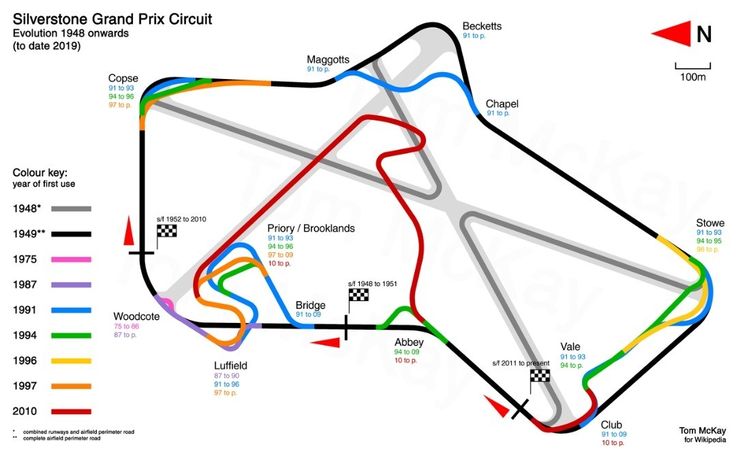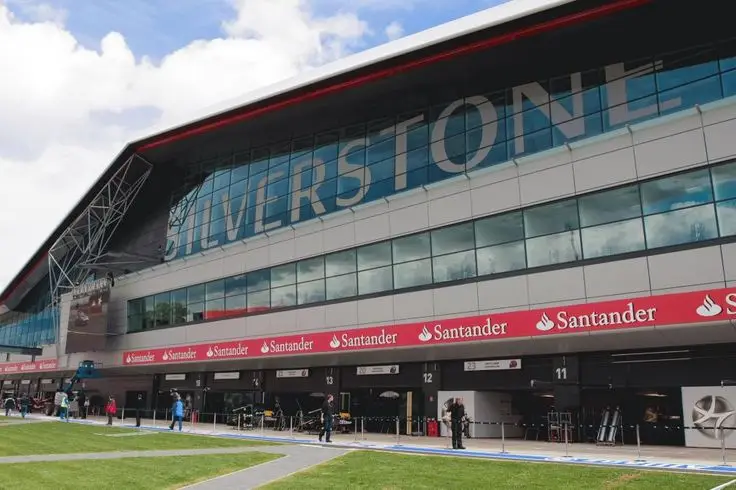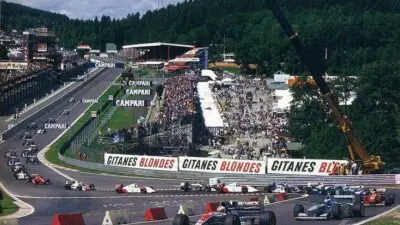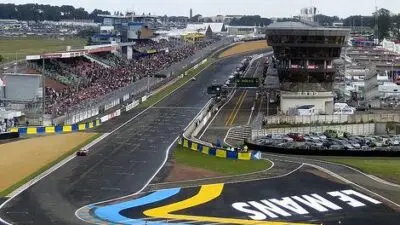Nestled in the heart of Northamptonshire, England, Silverstone Circuit stands as more than just a racing venue—it’s the beating heart of British motorsport heritage. Since hosting its first Grand Prix in 1948 and the inaugural Formula One World Championship race in 1950, this legendary track has cemented itself as a monument to speed, skill, and sporting excellence. Silverstone Circuit has evolved from a windswept former airfield into one of the most recognized and revered racing destinations in the world, earning its title as the official home of British motor racing.

The circuit’s distinctive layout features iconic corners like Copse, Maggotts, and Becketts that have challenged the greatest drivers across generations. Each year, thousands of fans flock to this hallowed ground to witness thrilling competitions across multiple racing disciplines, from the prestigious British Grand Prix to MotoGP events and endurance racing championships. The roar of engines and atmosphere of excitement create an unmistakable energy that captures the essence of motorsport culture.

Key Takeaways
- Silverstone Circuit has been the cornerstone of British motorsport since 1948, hosting the inaugural Formula One World Championship and continuing as the home of the British Grand Prix.
- The Northamptonshire track features technically challenging corners and high-speed straights that test the skills of world-class drivers across multiple racing disciplines.
- Beyond professional racing events, Silverstone offers driving experiences and interactive attractions that allow fans to connect with motorsport heritage year-round.
Silverstone Circuit: A Historic Evolution

Silverstone Circuit stands as one of motorsport’s most iconic venues, transforming from military airfield to racing legend over decades of development. Its 5.891 kilometers of asphalt have witnessed countless historic moments in British motorsport.
From RAF Silverstone to Motorsport Icon
RAF Silverstone began as a World War II Royal Air Force bomber station in Northamptonshire. After the war ended in 1945, the abandoned airfield caught the attention of racing enthusiasts. The Royal Automobile Club arranged the first impromptu races in 1947, using the runways and perimeter roads.
The circuit officially opened for motorsport in 1948, hosting the first British Grand Prix. Drivers raced around hay bales marking the track, with the three runways forming a triangular circuit layout.
Silverstone made history in 1950 when it hosted the very first Formula 1 World Championship race on May 13, establishing its place in motorsport heritage.
Key Milestones in Silverstone’s Timeline
1950: Hosted the inaugural Formula 1 World Championship race with King George VI in attendance.
1987: Construction of the Silverstone Wing, enhancing facilities and spectator experience.
1991: Significant track redesign to increase safety and create more overtaking opportunities.
2010: Major redevelopment including the new pit and paddock complex.
2018: Secured a long-term contract to continue hosting the British Grand Prix after uncertainty about its future.
Throughout these developments, Silverstone maintained its status as the home of British motor racing, hosting not only Formula 1 but also MotoGP, World Endurance Championship, and British Touring Car Championship events.
Circuit Redesigns and Technological Advancements
Silverstone’s layout has evolved significantly while preserving its high-speed character. The original perimeter track gave way to more complex configurations, with famous corners like Copse, Maggotts, and Becketts challenging drivers’ skills.
The 2010 redesign represented the most dramatic change, moving the start-finish straight and creating the “Arena” section. This modernization included:
- Advanced track surface materials for improved grip
- Enhanced safety barriers and run-off areas
- State-of-the-art timing systems and telemetry
- Improved spectator facilities with better viewing areas
The Silverstone Circuit now combines heritage with cutting-edge technology, maintaining its reputation for fast, flowing corners while meeting modern safety standards.
Recent investments in digital infrastructure allow teams to gather extensive data during races, helping them optimize performance around this challenging Northamptonshire track.
Legendary Layout and Iconic Corners

Silverstone’s circuit design combines high-speed straights with technical corner sequences that challenge even the most skilled drivers. The track’s unique layout and unpredictable weather conditions create an exhilarating racing experience that has defined British motorsport for decades.
Track Layout and Distinct Configurations
Silverstone Circuit stretches across 5.891 kilometers of Northamptonshire countryside, featuring 18 corners that blend technical challenges with breathtaking speed. Originally an RAF airfield during World War II, the track has undergone numerous modifications since hosting the first Formula 1 World Championship race in 1950.
The current Grand Prix layout, used since 2011, balances tradition with modern safety standards. It includes three primary sectors:
- Sector 1: Features the famous Abbey corner and Farm Curve
- Sector 2: Contains the legendary Maggotts-Becketts-Chapel complex
- Sector 3: Includes the high-speed Stowe corner and Club complex
Despite modifications, Silverstone has maintained its character as one of the fastest circuits in motorsport. The track’s wide surface and flowing nature encourage overtaking, creating spectacular racing moments that fans anticipate each season.
Famous Corners: Maggotts, Becketts, and Chapel
The Maggotts, Becketts, and Chapel sequence represents one of motorsport’s most challenging and revered corner combinations. This high-speed section demands absolute precision and tests both driver skill and vehicle aerodynamics.
Maggotts begins with a left-hand entry that immediately transitions into the five-part complex. As drivers navigate through these rapid direction changes, they experience extreme g-forces while maintaining speeds above 180 mph.
The corner names reflect Silverstone’s rich history. Maggotts was named after the nearby Maggot Moor, while Becketts references the medieval chapel of Thomas Becket that once stood nearby. Chapel marks the exit point of this legendary sequence.
This section separates great drivers from the merely good. The perfect line through these corners requires exceptional car control and bravery, as even minor mistakes result in significant time loss. Formula 1 drivers consistently rank this complex among their favorite challenges in the sport.
The Role of British Weather in Racing
British weather plays a dramatic and unpredictable role at Silverstone, adding an extra dimension to racing strategy. Rain can appear suddenly, even during otherwise sunny race weekends, creating treacherous conditions that test driver skill and team adaptability.
The circuit’s flat, open layout exposes it to wind and rapidly changing conditions. It’s not uncommon for one section of the track to be wet while another remains dry, forcing drivers to make split-second adjustments.
These variable conditions have produced some of Silverstone’s most memorable moments. Races often require multiple tire changes as teams gamble on weather forecasts, sometimes resulting in unexpected winners and dramatic position changes.
Drivers with exceptional wet-weather skills often shine here. The combination of high-speed corners and changing grip levels creates a unique challenge that has historically rewarded bravery and technical precision when conditions deteriorate.
Flagship Events at Silverstone

Silverstone Circuit hosts several prestigious motorsport competitions that attract hundreds of thousands of fans each year to Northamptonshire, England.
The British Grand Prix and Formula 1
The British Grand Prix stands as Silverstone’s crown jewel event. Since hosting the inaugural Formula 1 World Championship race in 1950, this historic circuit has become synonymous with British motorsport excellence.
The Grand Prix weekend typically occurs in early July, attracting record crowds that exceed 480,000 spectators. In 2024, Lewis Hamilton secured a record-breaking ninth British Grand Prix victory, further cementing the event’s legendary status.
Beyond the racing action, Silverstone transforms the Grand Prix into a complete festival experience. The event spans four days featuring live music, comedy performances, and extensive entertainment options for attendees of all ages.
The fast-paced corners and technical challenges of the 5.891-kilometer circuit create thrilling racing conditions that drivers both respect and fear. For British drivers, winning at Silverstone represents a career-defining achievement.
MotoGP and World-Class Motorcycle Racing
Silverstone also proudly hosts the British round of MotoGP, bringing the world’s premier motorcycle racing championship to UK shores. This high-speed spectacle showcases the extraordinary talents of motorcycle racers navigating the circuit’s challenging layout.
The MotoGP event delivers three classes of competition: MotoGP, Moto2, and Moto3. Each category offers distinct racing experiences with varying motorcycle specifications and racing approaches.
Motorcycle fans appreciate Silverstone for its excellent viewing opportunities around the circuit. The layout allows spectators to witness the incredible lean angles and breathtaking speed of these two-wheeled machines.
The event typically features practice sessions, qualifying rounds, and race day excitement spread across a full weekend. British riders receive exceptional support from the passionate home crowd, creating an electric atmosphere throughout the venue.
Diverse Motorsport Competitions

Silverstone Circuit hosts an impressive array of racing events throughout the year, showcasing different vehicle types and racing formats. The track’s versatile layout accommodates everything from touring cars to endurance races and historic competitions.
British Touring Car Championship
The British Touring Car Championship (BTCC) represents one of Silverstone’s most popular racing series. Since its modern format began in 1987, the BTCC has attracted thousands of fans to Silverstone each season.
The championship features modified production cars from manufacturers like BMW, Honda, and Toyota competing in close-quarter racing. Drivers battle through three races per event weekend, with reverse grids adding unpredictability.
Silverstone’s National Circuit configuration is typically used for BTCC events, providing excellent overtaking opportunities at Copse and Luffield corners. The championship visits the track twice yearly, usually in April and September.
Notable BTCC champions who’ve mastered Silverstone include Jason Plato, Matt Neal, and Colin Turkington. The series’ accessibility and relatively affordable tickets make it a fan favorite.
Endurance Racing and the British GT Championship
Silverstone serves as a premier venue for endurance racing, hosting the European Le Mans Series and World Endurance Championship events. The circuit’s International layout tests both machine reliability and driver stamina.
The 6 Hours of Silverstone traditionally opens the WEC season, featuring multiple classes of prototype and GT cars racing simultaneously. Teams must balance speed with fuel economy and tire management.
The British GT Championship brings GT3 and GT4 class sports cars to Silverstone for sprint and endurance formats. The series’ distinctive feature is its pro-am driver pairing requirement, where professional racers team with amateur drivers.
Silverstone’s challenging Maggots-Becketts-Chapel sequence particularly tests the aerodynamic capabilities of GT cars. The circuit typically hosts the championship’s flagship three-hour endurance race each season.
Historic and Grassroots Events
The Silverstone Classic, rebranded as the Silverstone Festival in recent years, stands as one of the world’s largest historic racing events. This annual celebration features over 20 races spanning motorsport history.
Visitors experience everything from pre-war vehicles to 1990s Formula 1 cars in competitive action. The paddock transforms into a living museum where fans can get close to iconic machines and meet racing legends.
Silverstone also nurtures grassroots motorsport through club racing events organized by groups like the British Racing & Sports Car Club. These affordable entry points for aspiring racers use various circuit configurations.
The track hosts numerous single-make championships including Caterhams, Ginettas, and MX-5s. Additionally, track days allow enthusiasts to drive their own vehicles on the same tarmac as Formula 1 stars, maintaining Silverstone’s reputation as the true home of British motorsport.
Unforgettable Experiences for Fans and Drivers

Silverstone offers a range of thrilling activities that allow both casual visitors and dedicated motorsport enthusiasts to connect with racing heritage. These experiences create lasting memories and provide unique insights into the world of high-speed competition.
Track Days and Driving Experiences
Silverstone delivers exceptional driving opportunities for those wanting to experience the thrill of this historic circuit firsthand. The Formula Single Seater experience puts visitors behind the wheel of a genuine racing car, creating a taste of what Formula 1 drivers experience.
Professional instructors guide participants through the same iconic corners that have challenged world champions. These sessions are suitable for various skill levels, from beginners to experienced drivers.
For those preferring supercars, Silverstone offers chances to drive prestigious vehicles like Ferraris, Aston Martins, and Lamborghinis on the famous track. The Ultimate Supercar Experience provides a comprehensive introduction to high-performance driving.
Track days are regularly scheduled, allowing enthusiasts to bring their own vehicles to test their skills on this legendary circuit.
Hospitality and Modern Facilities
Silverstone has transformed from a basic racing venue to a comprehensive entertainment destination with world-class facilities. The circuit features multiple hospitality options ranging from casual to premium experiences.
During major events like the British Grand Prix, exclusive hospitality packages provide gourmet dining, premium viewing positions, and sometimes access to driver appearances. These arrangements offer comfort while maintaining connection to the racing action.
The circuit’s layout prioritizes spectator enjoyment with strategic viewing areas and grandstands that maximize visibility of critical racing moments. Fans can witness dramatic overtaking maneuvers at key corners.
Recent renovations have modernized amenities throughout the venue. The Escapade luxury accommodations provide trackside lodging options for those wanting immersive race weekend experiences.
Silverstone Interactive Museum and Racing Memorabilia
The Silverstone Interactive Museum celebrates British motorsport heritage through engaging exhibits and authentic artifacts. This state-of-the-art facility opened in recent years, offering visitors a journey through racing history.
Interactive displays demonstrate the science behind motorsport, while historic vehicles showcase technological evolution. Visitors can examine legendary cars that competed in pivotal races throughout Silverstone’s history.
Racing memorabilia collections include driver equipment, trophies, and photographs documenting key moments from past events. Many items come with stories that connect visitors to dramatic championship battles.
The museum features simulators that recreate driving experiences from different eras, allowing guests to compare historical and contemporary racing challenges. Special exhibitions regularly rotate, ensuring repeat visitors discover new content.
Educational programs cater to different age groups, making motorsport accessible to younger enthusiasts and inspiring future generations of racing talent.
Silverstone’s Legacy and Ongoing Impact

Silverstone Circuit stands as a monument to British motorsport excellence, with decades of history shaping both its physical layout and cultural significance. Its influence extends far beyond race weekends, creating lasting impacts on technology, heritage preservation, and the future of motorsport.
Influence on Motorsport Innovation
Silverstone has consistently driven innovation in motorsport technology and safety standards. The circuit’s high-speed corners and technical sections have pushed engineers to develop more aerodynamically efficient vehicles and improved braking systems. These advancements often transfer to road cars, benefiting everyday drivers.
Teams testing at Silverstone have pioneered numerous technologies including advanced aerodynamics and electronic driver aids. The circuit’s challenging layout demands peak performance from both cars and drivers.
The facility also houses technology centers and motorsport businesses in its surrounding industrial parks. This concentration of expertise creates a hub for racing innovation and development.
Many Formula 1 teams maintain headquarters near Silverstone, creating a motorsport valley that fosters collaboration and technological advancement.
Preserving Motorsport Heritage
Silverstone has maintained its position as the spiritual home of Formula 1 while honoring its rich history. The circuit hosts the annual Silverstone Classic, one of the world’s largest historic racing events, showcasing vehicles from various eras.
The Silverstone Experience museum opened in 2019, preserving artifacts and stories from the circuit’s past. This interactive exhibition educates visitors about British motorsport heritage and Silverstone’s transformation from airfield to racing venue.
Key historic sections of the track remain, including famous corners like Copse and Stowe. These elements connect modern racing to the circuit’s storied past.
The preservation efforts extend to celebrating legendary drivers and iconic moments that have unfolded at the track since its first Grand Prix in 1948.
The Future Outlook for Silverstone
Silverstone continues to evolve with significant investments in facilities and infrastructure. Recent upgrades include improved spectator areas, hospitality venues, and track modifications to enhance racing action and safety.
The circuit has diversified its event calendar beyond Formula 1 to ensure year-round viability. This includes hosting:
- British Superbikes
- World Endurance Championship
- Music festivals and cultural events
- Track days and driving experiences
Environmental sustainability has become a key focus, with ongoing initiatives to reduce the carbon footprint of events. Solar power installations and waste reduction programs demonstrate the venue’s commitment to responsible operation.
Digital innovation allows Silverstone to connect with fans globally through virtual experiences and e-sports competitions. These technologies extend the circuit’s reach beyond physical attendance at events.
Frequently Asked Questions

Silverstone Circuit draws thousands of motorsport enthusiasts annually with its prestigious events and rich heritage. Visitors often have specific questions about schedules, tickets, facilities, and the track’s historical significance.
What events are scheduled at Silverstone for the upcoming racing season?
The Formula 1 British Grand Prix 2025 remains the highlight of Silverstone’s calendar, scheduled for July 2025. This premier event promises high-speed action and fierce on-track rivalries.
Silverstone also hosts the British Grand Prix MotoGP, featuring the world’s elite motorcycle racers competing on this challenging circuit.
The Silverstone Festival celebrates motorsport heritage with classic race cars and exhibitions. Additional events include the Kwik Fit British Touring Car Championship and European LeMans Series.
How can I purchase tickets for Formula 1 races at Silverstone?
Tickets for the Formula 1 British Grand Prix can be purchased directly through the official Silverstone website. Various packages are available, from general admission to premium hospitality options.
Mobile tickets are available for convenient entry, eliminating the need for physical tickets. Early booking is recommended as premium seats and hospitality packages often sell out months in advance.
Various hospitality locations include the Drivers’ Lounge, Silverstone Six, Formula One Paddock Club, Brooklands Restaurant, and Woodcote corner, each offering different viewing experiences and amenities.
Can you provide a map of the Silverstone circuit with key facilities and points of interest?
Silverstone Circuit spans two English counties—Northamptonshire and Buckinghamshire. This geographical quirk means visitors often cross county lines while exploring the venue.
Key viewing areas include Copse Corner, Maggots, the Wellington Straight, and Woodcote corner. The Silverstone Wing houses premium facilities including the Formula One Paddock Club.
Giant screens are positioned throughout the circuit, particularly at hospitality facilities like The Drivers’ Lounge, ensuring spectators never miss any racing action regardless of their viewing position.
What is the new lap record qualifying time at Silverstone, and who set it?
The Silverstone Circuit’s layout creates one of the fastest and most challenging tracks on the Formula 1 calendar. Its high-speed corners demand exceptional skill and courage from drivers.
The current configuration features iconic sections like Maggots and Becketts, where F1 cars demonstrate remarkable downforce and aerodynamic efficiency. These technical sequences separate good drivers from great ones.
Modern Formula 1 cars navigate Silverstone at average speeds exceeding 150 mph, with top speeds on the Hangar Straight approaching 200 mph during qualifying sessions.
How does Silverstone maintain its status as the ‘Home of British Motorsport’?
Silverstone maintains its prestigious status through continuous modernization while honoring its heritage. The circuit hosts Britain’s premier motorsport events, including Formula 1, MotoGP, and touring car races.
The venue invests in state-of-the-art facilities like the Silverstone Wing, enhancing the experience for competitors and spectators alike. These improvements maintain Silverstone’s competitiveness among global racing venues.
Silverstone offers year-round driving experiences and track days for both cars and motorcycles, making motorsport accessible to enthusiasts beyond professional events.
What are the historic milestones that marked Silverstone as a significant location in motorsport history?
Silverstone’s transformation from an RAF airfield to the home of British motor racing represents its most significant milestone. The circuit held the first official Formula 1 World Championship race in 1950.
Throughout the decades, Silverstone has witnessed legendary battles between motorsport icons like Jim Clark, Jackie Stewart, Nigel Mansell, and Lewis Hamilton. These historic contests cemented its place in racing lore.
The circuit has undergone multiple layout changes to meet evolving safety standards while preserving its challenging character. Despite these modifications, Silverstone retains the essence that makes it a driver favorite.



